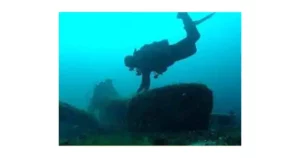Off the coast of the island of Fournoi in Greece lies a sunken graveyard.
“Here we discovered the largest concentration of ancient shipwrecks in the world,” said Peter Campbell, an underwater archaeologist and a Lecturer at Cranfield University in England. “The first group of ships we saw were from the third century A.D. We kept swimming and found some from the fourth century A.D., and kept swimming and found some from the second century B.C.”
Why did this area of the ocean claim so many ships? Where were these vessels heading? What was their cargo? What can they tell us about the past?
Those are some of the many mysteries that Campbell and other underwater archaeologists attempt to solve as they plumb the depths of lakes, rivers, and oceans, recovering pieces of history that have long been lost to the water.
Some of those archaeologists, like Campbell, got their start at UW-Milwaukee. Now, thanks to a new hire in UWM’s Anthropology Department, more students will be able to literally get their feet wet with a novel facet of excavation.
Down in the depths
Most people are familiar with archaeological digs on land. From the pyramids of Egypt to hidden temples in Southeast Asia, re-discovered ruins and artifacts have given researchers insights into the lives of ancient peoples. UWM’s Anthropology Department regularly leads students on excavations that scour Wisconsin’s ground for artifacts like pottery, stone sherds, arrowheads, and more.
But underwater archaeology is a different beast. For one thing, you need an air tank.
”The safety issues are paramount,” said Sara Rich, who earned her Master’s in Art History from UWM and is now a professor of honors and interdisciplinary studies at Coastal Carolina University.
Rich is a maritime archaeologist whose explorations have led her to excavations in the English Channel, the Mediterranean Sea, and even the rivers of South Carolina.
Just like any scuba diver, underwater archaeologist must be mindful of how much oxygen is in their air tank. They must be in good shape to swim and dive. Then there’s the pressure to consider: At deep depths, the weight of the water bearing down on a diver compresses the nitrogen in their bloodstream. If divers resurface too quickly without allowing the nitrogen time to reabsorb into their bodies, they can end up with life-threatening decompression sickness.
Plus, nitrogen can make you feel a little loopy when you’re under the water, said Rich.
“Even at shallower sites, nitrogen narcosis is a thing. Nitrogen doesn’t just threaten you with the bends; it also affects your brain,” she said. “You get down to the bottom and you start doing silly things or you forget what you’re doing down there at all. You have to make a list on a slate and then check the things on that list … otherwise, you will not remember and you’ll mess everything up.”
So when faced with all of these safety issues, why bother risking life and limb to excavate underwater sites?
“You can do archaeology on land, and a lot of us do, but the data underwater is vastly, vastly better most of the time, than working on land,” Ashley Lemke explained. “It gives you a finer picture of what life in the past was like.”
Lemke joined the UWM Anthropology Department in September as its newest faculty member. She specializes in underwater archaeology and has been teaching a class on it this fall.
The process of excavation
An underwater archaeological dig actually begins on land. Researchers first talk to locals to leverage their knowledge about where to dive. That’s how Campbell and his
colleagues found the ship graveyard in the Fournoi Islands.
“We were working with the local fisherman and sponge divers,” he recalled. “Some of them had circled this one rocky cliff face. The sponge divers said, dive right here and you’ll find a forest.”
Once they have a likely location, scientists use tools like sonar or multibeam to make two- or three-dimensional images of the landscape below the surface. They can
also send down Remote Operated Vehicles – Lemke has named hers Jake – which are small robots that can take pictures of the excavation site. When the archaeologists have a good idea of where they’re going, they go diving. At
deeper sites, where divers might experience issues with nitrogen, researchers can stay under the water for only about 20 minutes at a time. They may take hundreds of
photographs of the site and stitch those images together on the surface to build a 3D model of the excavation.
“You have a record of the layers of the shipwreck,” said Rich. “It also makes it a lot easier to track looting.”
The things they find are fascinating. Shipwrecks are obviously interesting and full of archaeological evidence to offer information about the past. But sometimes, there are civilizations beneath the waves.
Lemke studies hunter-gatherer societies among early Native Americans – specifically ones that lived in areas that have been subsequently covered by the Great Lakes. Lemke got her research start in Lake Huron in search of sites constructed by early indigenous groups that were submerged when water levels on the Great Lakes rose.
Rich has also explored submerged settlements, this time in the English Channel, and says the information from history gives us insight into emerging patterns today.
“As the polar ice has melted in the Holocene, of course you have a lot of saltwater ingress into previously occupied terrestrial areas. As that landscape was drowned, the people who lived there moved to higher ground,” she noted. “It’s almost like an early proxy for what we’re seeing now as sea levels rise.”
“When you start looking at the past and that shared history of humanity, you can’t help but be surprised by how similar we all are,” Lemke said.
By Sarah Vickery, College of Letters & Science
